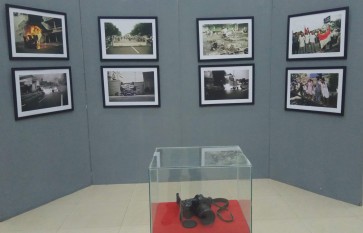Popular Reads
Top Results
Can't find what you're looking for?
View all search resultsPopular Reads
Top Results
Can't find what you're looking for?
View all search resultsItalian art in retrospective
Luigi OntaniâI am very superficial,â Italian artist Luigi Ontani jokes â his words echoing artist Andy Warholâs famous sentence
Change text size
Gift Premium Articles
to Anyone

Luigi Ontani
'I am very superficial,' Italian artist Luigi Ontani jokes ' his words echoing artist Andy Warhol's famous sentence.
And indeed, the Italian maestro has a fair resemblance to Warhol ' both use the same kind of irony in their art, reusing famous icons and putting these in a new context.
In his works, Ontani uses various media, mainly photography, performance art, tableaux vivants, sculptures, installations and drawings to explore themes, such as identity and transformation.
International museums like the Centre Pompidou in Paris, the Guggenheim and the Museum of Modern Art (MOMA) in New York, as well as the Stedelijk Museum in Amsterdam have exhibited his works in the past, and his work was also featured in the Venice Biennale.
His own body has also become the center of his art, such as in one of his famous pieces, the series Tableux Vivants (1969-ongoing), where Ontani uses famous icons or references to history ' playing with identity.
'My adventure is a desire between art and life, with all the contradictions and weaknesses this represents. With humor, affection and love for art. It is an exploration of vanity as selfishness and an aversion for existence, and thus a striving for the elsewhere, alienation, that only art can give me,' explains the artist.
Ontani's works are on display at the Kayu art space as part of Italian curator Lucie Fontaine's branch in Ubud, Bali.
The artist, who was at the Italian Institute of Culture to talk about his exhibition, named his first
exhibition outside of Italy in the early 1970s as an important moment as it was the first time an exhibition focused on transformation itself and not on art.
The exhibition, titled 'Transformer: Aspects of Travesty', was showcased at the Richard Saltoun Gallery in London, curated by Jean-Christophe Ammann,and explored non-normative sexualities and the production of identity.
Ontani said his fascination motivated him to travel around the world and research the various rituals and traditions of transformation.
'My first travel is with my identity; with my face, a very simple symbol, I can create different identities. I travel with my personality. But I like all kinds of traveling ' traveling in time, place, in the history, in the mythology and in identity,' the artist explains.
Researching rituals surrounding masks, Ontani traveled to Japan, Thailand, India, Sri Lanka and more.
In Bali, he found masks with the most resemblance to the masks of his imagination and the best collaboration with local artists.
Working together with Balinese artists Ida Bagus Anom, I Wayan Tangguh, his son Sukarya and Made Lopang in Bali enabled Ontani to integrate into the community more than he did for his works in other countries.
His ongoing exhibition, titled 'IdeTriBali' ' which combines the words 'idea', 'tribal' and 'Bali' ' runs until April 8 at Kayu's space and in six Joglo (traditional houses) in the Rumah Topeng Dan Wayang compound.

The works include a selection of his new masks and wayang kulit (leather shadow puppets) as well as projections of Tableaux Vivants.
The artist, who calls the masks he made 'hybridoli' ' a hybrid of idols ' also held performances. One of them was Tavolozza RifioRITO, which involved 12 people wearing Ontani's masks while performing inside a flower composition in the shape of a palette.
The palette appears to be a recurring subject in Ontani's art, as seen in his performance piece in Rome, which involved 12 people standing in the shape of a palette as well. The performers wore masks, personifying great artists and Ontani's inspirators that lived on Rome's famous street of Via Margutta.
'I am like the palette,' he explains, 'It's my identity, the mask is my face made bigger'.
He also seemed to be traveling back and forward in time in conversation, jumping quickly to different topics, ranging from archeology and Roman art to Lévi-Strauss.
His use of ambivalent symbolism and references in his art, put in a contemporary context, asks for a deeper exploration and seems anything but superficial. 'Art doesn't know time,' the artist smiles.
_____________________
The writer is an intern at The Jakarta Post. For further details, log on to kayu-luciefontaine.com
' Photos Courtesy of Istituto Italiano di Cultura Jakarta









